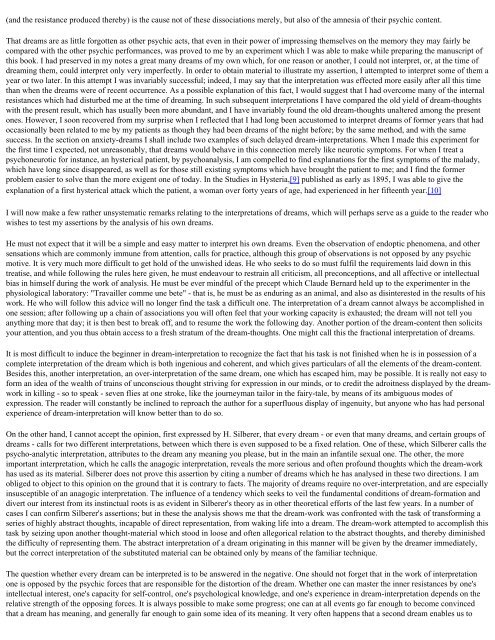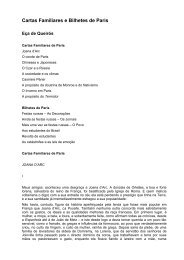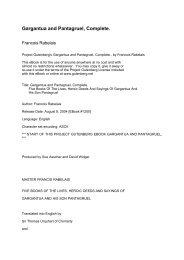The Interpretation of Dreams Sigmund Freud (1900)
The Interpretation of Dreams Sigmund Freud (1900)
The Interpretation of Dreams Sigmund Freud (1900)
Create successful ePaper yourself
Turn your PDF publications into a flip-book with our unique Google optimized e-Paper software.
(and the resistance produced thereby) is the cause not <strong>of</strong> these dissociations merely, but also <strong>of</strong> the amnesia <strong>of</strong> their psychic content.<br />
That dreams are as little forgotten as other psychic acts, that even in their power <strong>of</strong> impressing themselves on the memory they may fairly be<br />
compared with the other psychic performances, was proved to me by an experiment which I was able to make while preparing the manuscript <strong>of</strong><br />
this book. I had preserved in my notes a great many dreams <strong>of</strong> my own which, for one reason or another, I could not interpret, or, at the time <strong>of</strong><br />
dreaming them, could interpret only very imperfectly. In order to obtain material to illustrate my assertion, I attempted to interpret some <strong>of</strong> them a<br />
year or two later. In this attempt I was invariably successful; indeed, I may say that the interpretation was effected more easily after all this time<br />
than when the dreams were <strong>of</strong> recent occurrence. As a possible explanation <strong>of</strong> this fact, I would suggest that I had overcome many <strong>of</strong> the internal<br />
resistances which had disturbed me at the time <strong>of</strong> dreaming. In such subsequent interpretations I have compared the old yield <strong>of</strong> dream-thoughts<br />
with the present result, which has usually been more abundant, and I have invariably found the old dream-thoughts unaltered among the present<br />
ones. However, I soon recovered from my surprise when I reflected that I had long been accustomed to interpret dreams <strong>of</strong> former years that had<br />
occasionally been related to me by my patients as though they had been dreams <strong>of</strong> the night before; by the same method, and with the same<br />
success. In the section on anxiety-dreams I shall include two examples <strong>of</strong> such delayed dream-interpretations. When I made this experiment for<br />
the first time I expected, not unreasonably, that dreams would behave in this connection merely like neurotic symptoms. For when I treat a<br />
psychoneurotic for instance, an hysterical patient, by psychoanalysis, I am compelled to find explanations for the first symptoms <strong>of</strong> the malady,<br />
which have long since disappeared, as well as for those still existing symptoms which have brought the patient to me; and I find the former<br />
problem easier to solve than the more exigent one <strong>of</strong> today. In the Studies in Hysteria,[9] published as early as 1895, I was able to give the<br />
explanation <strong>of</strong> a first hysterical attack which the patient, a woman over forty years <strong>of</strong> age, had experienced in her fifteenth year.[10]<br />
I will now make a few rather unsystematic remarks relating to the interpretations <strong>of</strong> dreams, which will perhaps serve as a guide to the reader who<br />
wishes to test my assertions by the analysis <strong>of</strong> his own dreams.<br />
He must not expect that it will be a simple and easy matter to interpret his own dreams. Even the observation <strong>of</strong> endoptic phenomena, and other<br />
sensations which are commonly immune from attention, calls for practice, although this group <strong>of</strong> observations is not opposed by any psychic<br />
motive. It is very much more difficult to get hold <strong>of</strong> the unwished ideas. He who seeks to do so must fulfil the requirements laid down in this<br />
treatise, and while following the rules here given, he must endeavour to restrain all criticism, all preconceptions, and all affective or intellectual<br />
bias in himself during the work <strong>of</strong> analysis. He must be ever mindful <strong>of</strong> the precept which Claude Bernard held up to the experimenter in the<br />
physiological laboratory: "Travailler comme une bete" - that is, he must be as enduring as an animal, and also as disinterested in the results <strong>of</strong> his<br />
work. He who will follow this advice will no longer find the task a difficult one. <strong>The</strong> interpretation <strong>of</strong> a dream cannot always be accomplished in<br />
one session; after following up a chain <strong>of</strong> associations you will <strong>of</strong>ten feel that your working capacity is exhausted; the dream will not tell you<br />
anything more that day; it is then best to break <strong>of</strong>f, and to resume the work the following day. Another portion <strong>of</strong> the dream-content then solicits<br />
your attention, and you thus obtain access to a fresh stratum <strong>of</strong> the dream-thoughts. One might call this the fractional interpretation <strong>of</strong> dreams.<br />
It is most difficult to induce the beginner in dream-interpretation to recognize the fact that his task is not finished when he is in possession <strong>of</strong> a<br />
complete interpretation <strong>of</strong> the dream which is both ingenious and coherent, and which gives particulars <strong>of</strong> all the elements <strong>of</strong> the dream-content.<br />
Besides this, another interpretation, an over-interpretation <strong>of</strong> the same dream, one which has escaped him, may be possible. It is really not easy to<br />
form an idea <strong>of</strong> the wealth <strong>of</strong> trains <strong>of</strong> unconscious thought striving for expression in our minds, or to credit the adroitness displayed by the dreamwork<br />
in killing - so to speak - seven flies at one stroke, like the journeyman tailor in the fairy-tale, by means <strong>of</strong> its ambiguous modes <strong>of</strong><br />
expression. <strong>The</strong> reader will constantly be inclined to reproach the author for a superfluous display <strong>of</strong> ingenuity, but anyone who has had personal<br />
experience <strong>of</strong> dream-interpretation will know better than to do so.<br />
On the other hand, I cannot accept the opinion, first expressed by H. Silberer, that every dream - or even that many dreams, and certain groups <strong>of</strong><br />
dreams - calls for two different interpretations, between which there is even supposed to be a fixed relation. One <strong>of</strong> these, which Silberer calls the<br />
psycho-analytic interpretation, attributes to the dream any meaning you please, but in the main an infantile sexual one. <strong>The</strong> other, the more<br />
important interpretation, which he calls the anagogic interpretation, reveals the more serious and <strong>of</strong>ten pr<strong>of</strong>ound thoughts which the dream-work<br />
has used as its material. Silberer does not prove this assertion by citing a number <strong>of</strong> dreams which he has analysed in these two directions. I am<br />
obliged to object to this opinion on the ground that it is contrary to facts. <strong>The</strong> majority <strong>of</strong> dreams require no over-interpretation, and are especially<br />
insusceptible <strong>of</strong> an anagogic interpretation. <strong>The</strong> influence <strong>of</strong> a tendency which seeks to veil the fundamental conditions <strong>of</strong> dream-formation and<br />
divert our interest from its instinctual roots is as evident in Silberer's theory as in other theoretical efforts <strong>of</strong> the last few years. In a number <strong>of</strong><br />
cases I can confirm Silberer's assertions; but in these the analysis shows me that the dream-work was confronted with the task <strong>of</strong> transforming a<br />
series <strong>of</strong> highly abstract thoughts, incapable <strong>of</strong> direct representation, from waking life into a dream. <strong>The</strong> dream-work attempted to accomplish this<br />
task by seizing upon another thought-material which stood in loose and <strong>of</strong>ten allegorical relation to the abstract thoughts, and thereby diminished<br />
the difficulty <strong>of</strong> representing them. <strong>The</strong> abstract interpretation <strong>of</strong> a dream originating in this manner will be given by the dreamer immediately,<br />
but the correct interpretation <strong>of</strong> the substituted material can be obtained only by means <strong>of</strong> the familiar technique.<br />
<strong>The</strong> question whether every dream can be interpreted is to be answered in the negative. One should not forget that in the work <strong>of</strong> interpretation<br />
one is opposed by the psychic forces that are responsible for the distortion <strong>of</strong> the dream. Whether one can master the inner resistances by one's<br />
intellectual interest, one's capacity for self-control, one's psychological knowledge, and one's experience in dream-interpretation depends on the<br />
relative strength <strong>of</strong> the opposing forces. It is always possible to make some progress; one can at all events go far enough to become convinced<br />
that a dream has meaning, and generally far enough to gain some idea <strong>of</strong> its meaning. It very <strong>of</strong>ten happens that a second dream enables us to









